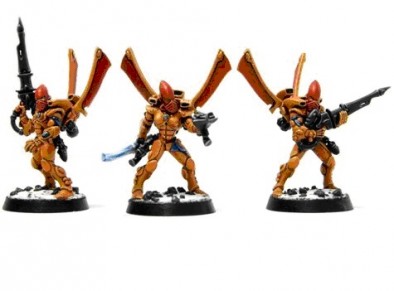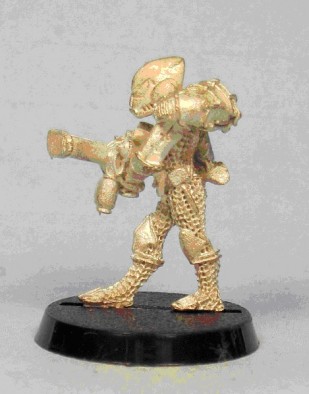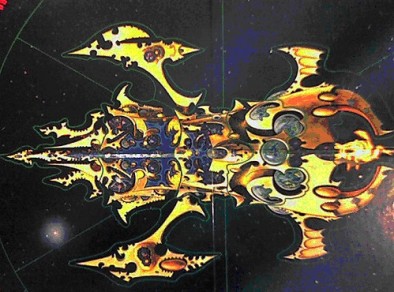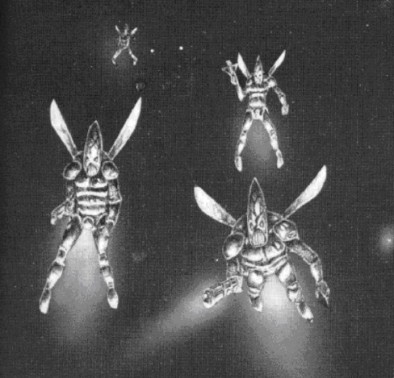From Empire To Fall: The Development Of The Eldar Part 1
June 19, 2013 by crew
The Eldar are one of the most ancient races at large in the Warhammer 40k universe but their lineage within the game proper is just as long running. Conceived as ‘space elves’ in Rick Priestly’s proto-Rogue Trader space battle game from before he joined Games Workshop they began as an antagonist race to pit against the forces of man along with the Orks. The premise was that the Empire of Man was under constant attack from piratical raiders of which the Eldar were but one faction. This idea would be brought over when the space game evolved into Rogue Trader Warhammer 40,000.
Proto-Eldar
When Games Workshop announced that it was to produce a miniatures skirmish science fiction game back in 1986 a series of models were created to give an idea of what the races who would inhabit this world would look like. The first Eldar produced was technically a Dark Eldar! 'Dark Elf Space Trooper' was recognisably a very early Guardian. Covered in mesh armour and sporting the distinctive pointed helm the model actually resembles the Guardians of today perhaps more than the Guardians that immediately followed it. Its sunken face plate and prominent back pack being design cues that would not reappear within the line until many years later. Armed with a flamer it is posed stalking forward quietly to take whichever unfortunate victim it has spied unawares.
Originally Games Workshop intended that players would convert up the majority of their force from existing fantasy miniatures so the starting races borrowed heavily from the fantasy ranges they already produced. That Rick Priestly had used the fantasy archetypes to populate his sprawling galaxy of the far future helped too. As the game grew in popularity during design and testing models specific to the game were put into production.
With the release of Warhammer 40,000 Rogue Trader the Eldar received their first few paragraphs of background and a dozen miniatures representing typical ‘Space Elves’. They were an ancient alien race who closely resembled humans but with pointed ears and pale skin. So genetically similar were they that interbreeding was possible leading many to believe that Eldar and Man shared a common ancestor, heresy!
Games Workshop was quite fond of the idea of inter-breeding in its fiction. Half-Orcs were to be found if you wandered around the Old World for long enough and what happened to your buxom maidens should there be a Fimir village in the depths of the local swamp is best left well alone. Mercifully Eldar physiology would receive a retcon in time.
The 2006 book ‘Xenology’ from Black Library featured extensive notes on the dissection of a captured Eldar Ranger. Plenty of subtle yet unnerving differences were to be found upon a biologist's surgical gurney such as Eldar teeth were outgrowths of their skulls and part of the jaw, no body fat (so no problems with obesity on the Craftworlds), no obvious digestive tract and DNA at least twice as complex as our own.
Within the pages of the Rogue Trader WH40K rulebook Craftworlds existed though at this point no explanation was given as to why the Eldar lived solely on these gigantic self-sufficient palace worlds The early Eldar did make use of the webway to travel throughout the galaxy and could be frequently found on Imperial worlds as traders and merchants.
A lot of Imperial worlds seemed lax in their persecution of their responsibilities as defined in the Pax Imperialis to purge the xeno. The Eldar did not need to trade as the Craftworlds were self-sufficient but rather journeyed for entertainment and adventure. So it was that groups of Eldar would enter the employ of planetary governors as mercenaries who players could take control of as heroes or villains in their games of Rogue Trader.
Pirates & Corsairs
In 1988 Games Workshop followed up the release of the Rogue Trader rule book with ‘Book of the Astronomicon’. This tome included new force lists for various mercenary bands including Eldar Pirates. The example force given in the book was for Yriel’s Raiders who would eventually go on to become Prince Yriel’s Eldrich Raiders, saviours of Iyanden in 40k lore. In fact, if you were to look at the sixth edition Eldar Codex you will find a squad of guardians painted in the distinctive black and yellow striped helms of those original Rogue Trader miniatures accompanying the modern version of Yriel into battle.
Eldar pirates were led by a cruel yet brilliant Captain who would style himself as a king amongst the stars. Distrustful of their kin these Captain-kings would employ hulking reptilian centaur Zoats as their personal bodyguard. Psykers existed within the race at this point though not in the guise we know today. The Captain and his senior officers were all listed as psykers which in the 40k of today would see these wild outcasts courting with disaster by embracing their psychic potential and in turn would unbalance their minds. Of course back then all any psyker had to worry about was the occasional demonic possession or Enslaver attack.
Fleshing out the army list were various squads with varying degrees of specialist equipment, all Imperial of course. It would be third edition 40K before the Eldar would drop lascannons for Bright lances and the like. Jetbikes and Eldar Dreadnought robots rounded off the list. Dreadnoughts of old had their iconic lanky stature and domed head but were AI constructs rather than necromantic automata.
Due to the limited number of vehicle models available stolen speeders and scratch build grav-attacks (hoverers) were present in the list as stolen booty. This idea of a cruel and charismatic individual leading bands of raiders across the stars pillaging and killing as they may would in later years coalesce into both the Eldar Corsair bands and the Dark Eldar.
Corsairs would remain as the ship borne pirates attacking Imperial shipping, outcasts from the Eldar path who courted their own destruction outside of the strict confines of Eldar society. Open to the predations of chaos and embracing the full gamut of emotional highs and lows the Eldar mind could experience they would be cast as unpredictable rogues, at one minute sanguine and calm and the next filled with murderous rage.
If you want to take to the board with a gang of murderous yet sometimes cheeky Eldar pirates then you can as Imperial Armour Volume 11: The Doom of Mymeara allows you to recreate Corsair bands like Yriel’s Eldrich Raiders. Forge World even produces jet pack Corsairs that mimic one of the iconic pieces of art within the Rogue Trader 40K rule book.
From here the Eldar would see the inclusion of some more outlandish and ornate units that would flesh out their race even further and you can find out more about that in part two of this retrospective.
 The idea of alien bodyguards being the only creatures trustworthy enough to not try and kill their master at the slightest opportunity would be carried over to the Dark Eldar Archon’s retinue where you can employ Sslythe to catch those bullets in the back and Medusa to relive the experiences of battles past. The Dark Eldar have also been known to act in a mercenary capacity though only for their own amusement, be it to enslave an entire Tau colony, or merely to giggle behind their monkeigh-skin veils and face masks at the lengths some Craftworlds will go to in order to survive.
The idea of alien bodyguards being the only creatures trustworthy enough to not try and kill their master at the slightest opportunity would be carried over to the Dark Eldar Archon’s retinue where you can employ Sslythe to catch those bullets in the back and Medusa to relive the experiences of battles past. The Dark Eldar have also been known to act in a mercenary capacity though only for their own amusement, be it to enslave an entire Tau colony, or merely to giggle behind their monkeigh-skin veils and face masks at the lengths some Craftworlds will go to in order to survive.
That was how the Eldar would remain until 1989 when a kaleidoscope of colour would backflip onto the war torn battlefields of the 41st millennium which will be explored in our next article.
Lee Trayler
Supported by (Turn Off)
Supported by (Turn Off)
Supported by (Turn Off)































![TerrainFest 2024 Begins! Build Terrain With OnTableTop & Win A £300 Prize! [Extended!]](https://images.beastsofwar.com/2024/10/TerrainFEST-2024-Social-Media-Post-Square-225-127.jpg)















































Good read, I do remember the eldar being able to take alot of imperial gear in second edition, always seemed bit odd.
I seem to remember the harlequins just couldn’t be bothered with maintaing gear ( too busy working on their dance moves) so just scavenged what they wanted from battlefields….painted them shocking colours and used them untill they died. I think their was a breakdown roll or something?! All seems a bit Orky now…..
Normal guys did have las pistols etc as well though didn’t they. Infact I think I have an early model with a powerfist, powersword and bionic leg somewhere…..now thats a Rogue Eldar…
Very good article here, a really impressive level of research. Can’t wait for part 2.
I’m loving this article, good work!
Looking forward to part 2 as I own a Rogue Trader-era Harlequin troupe.
Really great article. There has been a nice splattering of great informative “serious” articles recently and they are very much appreciated. This one will have me down the shed digging out my old eldar after work tonight….feeling inspired. Great stuff Lee.
PS zoats were awesome.
This article was a pleasant addition.I’m looking forward to the next part.